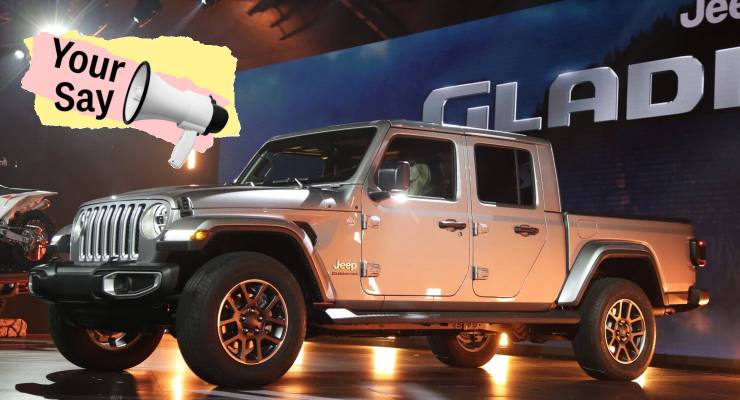
Robyn Griffiths writes: These monsters not only cause problems on the road, but if one parks next to you, drivers in a smaller car can’t see to pull out of their parking space (“Here’s how to make American mega-trucks unwelcome Down Under”). They also take up huge amounts of space when they insist on reversing in to park, and if the smaller car has driven in, not reversed, it’s impossible to see around them so you need to creep out really slowly so you can check for oncoming cars.
And what they do to the environment with bigger emissions is unacceptable.
Margaret Hurle writes: I drove four-wheel-drive utes for 35 years while living and working on a farm. I needed them because of the condition of the public roads and to get around the paddocks. When I retired, I looked at buying a similar vehicle, as I still had some farm work to do. However, all the current (2013 or so) models were 10cm higher than my old ute. I couldn’t stand beside them and reach into the floor of the tub. “Well, you can stand on the rear wheel,” a salesman told me. And lift out a 20kg item? Yeah, right. Lots of health and safety issues there. I went for a smaller, lighter vehicle. Besides all the road safety problems, I don’t see how mega-utes are practical for average-sized people. Or perhaps, as the author suggests, they just tow jetskis.
Maurice Lindsay writes: A wider attack on the proliferation of these vehicles should really encompass any vehicle built for purpose but used as something other than intended. If a vehicle is built to satisfy a certain need for tradies et al but is used as a family’s or an individual’s transport then that is a complete conflict of purpose and without question should be highly regulated, just like any other business-based machinery. Semi-trailers, buses and Abrams tanks may as well be justified as recreation vehicles as are these behemoths of masculine display.
And the increased danger to other road users and pedestrians is the bottom line. Trade business vehicles, whether in a collision with pedestrians or other vehicles, are at a significant advantage structurally. And this is one of their main attractions to those who would use them as a daily drive and the main reason for forcing a rethink on their availability and their use.
Basil Powley writes: Well, you sooks, stick to your dangerous mobile shopping trolleys and let the people with their feet on the ground buy whatever vehicle they like. Driving down to the trendy cafe for your morning coffee and smashed avos in your buzz-box might suit you, but some of us need larger vehicles to tow a caravan. There’s a real world out there beyond the last set of traffic lights.
I would rather have these so-called monster trucks in our community than you green-eyed lefty monsters. Get a life.
Jill Saunders writes: I have a tiny smart car for economic and environmental reasons.
I only need to move myself and two small dogs around and see no need to have a massive gas-guzzling ute to do so, unlike most male-driven purchases (as your piece pointed out) of these huge ego-stroking gas-guzzlers.
Mercedes-Benz has discontinued this smart car in Australia due to low sales because most Australians don’t seem to grasp the concept or feel the need to rein in their expenditure or desire for these massive cars. In Australia you have to take up a parking place in a parallel fashion, as opposed to Europe where you can park sensibly nose to kerb in these tiny cars, so that there is more space available for other small cars that proliferate in European cities. Easy to park and less than $25 a week in petrol. It’s a no-brainer — except in Australia of course.
The other barrier to the adoption of smaller cars is that there is no incentive to do so in terms of registration. My car cost me $700-odd to register every year regardless of the fact that it is 700cc like a motorcycle, which is absurd.
Ross Grange writes: I fully agree, to a point, with all comments regarding large utilities/trucks and SUVs. But my objection is that when we decided to purchase a vehicle that would fit our needs, the choice was limited. Because of back and neck problems and reduced flexibility in my knees, I found all sedans and station sedans were too low and therefore extremely difficult to access, and people-movers were too much like commercial vans and too large for just two people plus the occasional one or two passengers. The only two vehicles that fitted the bill as close as possible were the Ford Territory and the Jeep Grand Cherokee, and even these two were a bit tight.
If we want people to buy smaller and more economical vehicles, particularly as they age, then stop the trend of low, super-streamlined vehicles and look at producing cars that you don’t have to be a human accordion to access.
Bill Robinson writes: Even the larger Asian utes are too big for our streets and parking spaces. As well as better emission standards, perhaps a size limit could be imposed at (say) no more than 5.5m long and no more than 1.9m wide. Anything outside those limits is treated like a truck or caravan combination and restricted to 500m outside the normal parking and driving areas.
Richard Creswick writes: I too am critical of the incremental growth of vehicle sizes having watched Corollas, RAV4s and Hilux all getting bigger. My daily drive is a small 24-year-old sports car, which is dwarfed by some of the vehicles it mixes with on the roads. It’s so low that twice in three weeks I was collected by SUVs reversing into parking spaces and not seeing me in their mirrors.
I regard the huge Yank utes as obscenities and would ban them from entering cities, car parks or even towns. I think people should be required to get special licences to drive them. Better still impose a weight tax on vehicles. I would be laughing.
Joan Rankine writes: How dare Robert Lechte accuses drivers of being the problem on roads (“Victim blaming has made cars the biggest killer of children in Australia”)! Get off your bike and start to look at the damage caused by cyclists and pedestrians. They don’t look where they are going, they wear dark clothes at night, they expect drivers to look out for them, and they just keep going oblivious to everything around them.
People need to go into schools to educate children on how to behave in traffic because no-one else tells them. As a retired teacher, I know that we used to tell them to look right, then left, then right again. Then it became look all around you as you cross the road. Now they teach nothing so they go around in a daze.
I’m sick of you arrogant cyclists and your demands. This is Australia — a big country, not Europe, the continent of small lands. Stop trying to turn us into Europe.








Basil Powley can’t be a real person??. However, the comment sums up societies situation/ attitude perfectly; namely I will do what I like and I don’t care how it affects others or the environment! Peak selfishness on display. As for Joan Rankin, she talks about the ‘damage done by cyclists’ without giving any examples! A poor choice of words when all you the evidence is that any damage is inflicted on cyclists, not motorists. My experience is that a small number of cyclists are not clever by wearing dark clothing and little lighting, however they are the minority! Joan sounds pretty entitled and selfish also. There is theme here!
Yeah I’m puzzled as to why these trolls are published. We need diversity of opinion, but those were largely pointless, content free, culture war rants. Perhaps there is just very little to chose from.
i wonder if Basil realises you can tow a caravan without resorting to one of these kid-killer utes – and then poor, old Joan doesn’t seem to understand that cyclists are usually commuting *within* a city
the thing is, since the day the automobile was invented, drivers have asserted their rights over everyone else – the fact that these drivers (Bas & JR) have greed-driven corporations on their side has only made them even more toxic
They’re married to each other.
A pair of ignorant sooks me thinks
Don’t be a tool, choose the right tool for the job.
https://youtu.be/V6ChTqII-Yk
…comment not directed at you pmac
Joan has her own comic strip
https://www.andysinger.com/bikesample9.html
“the damage caused by cyclists and pedestrians”.
What, to your paint job when you run them over?
Hey, trying to hose bits of small child out of the chassis and the radiator is no laughing matter. It takes a lot of time, and the vehicle smells if you fail to do it effectively. And your own kiddies might be traumatized by the occasional pedestrian or cyclist being squashed; there’s that damage to consider. And what about the actual cycles? They can puncture tyres and ruin the enamel! At least a decent size ute can just ride over mobility scooters, but if you take out too many of them, your insurance premiums hit the roof.
I am keen to see actual examples of Joan Rankine’s “damage caused by… pedestrians”. Bikes can get up to a reasonable speed, so the combination of mass and velocity could potentially result in a fair amount of force. But pedestrians? Is she driving a Ford Hyperbole, or is it Toyota that makes that model?
I mostly ride, but when driving the cyclists gliding past me, looking fit and smug as I am miserable, trapped motionless in traffic, causes a lot of emotional damage.
Ahhh yes. I decided not to comment previously but I have two vehicles. A 500HP two litre hatchback. Sat it beside an old mini recently and was amazed how big it was by comparison. As an old mini driver I was surprises. As the song goes “The nips ate getting bigger.” However most of the time I travel in Clark Kent mode in my MB Vito Van. Lazy and comfortable. Even in this the visual impediment of the larger black smoke blowing 4WD with a modified exhaust is simply repugnant.
Yes I agree – increase registration fees, require HV Licenses, and limit access to shopping centres and city areas. Use financial disincentives.
Got some bad news for you. The same kinds of people who don’t want anyone driving around in big cars, also don’t want anyone driving around in fast cars.
It’s not the speed capability, it’s the pollution.
The pollution from vast numbers of old vehicles is far more than the handful of high performance vehicles.
Being able to see where you are heading is also a useful safety feature in most normal vehicles but not the truckzillas. Truckzillas also overtop guardrail and are more prone to roll-overs. These vehicles are increasingly problematic in the USA, our future if unchecked.
https://nacto.org/program/vehicle-design/
Hate behemoths here, but no problem with fast cars, except for the fact they should be electric by now
Parking inspectors should fine vehicles for parking outside delineated parking spaces. Cities should progressively ban diesel vehicles. Caravan owners should limit the use of towing vehicles and not use them for commuting or regular city driving. Genuine farm vehicles garaged outside city limits should be exempted. Mega truck trade vehicles should only be owned by corporations.